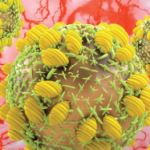Immunosuppression is the first choice for therapy for major organ involvement. Colchicine is prescribed most often for mucocutaneous involvement. A 2.5-mg/kg daily dose of azathioprine can be prescribed to treat eye disease, to lessen its severity and the frequency of hypopyon attacks, and to preserve vision. It can also be used for oral and genital ulcers and for arthritis. Because the onset of action is slow, often at least three months, “we don’t give up on the drug until six months. You have to take the right dose for the appropriate amount of time,” Dr. Yazici said.
Risk of HCV and HBV in Rheumatic Diseases
Leonard Calabrese, DO, professor of medicine in the department of rheumatic and immunologic diseases at Cleveland Clinic Lerner College of Medicine, focused his presentation on viral infectious arthritis on two viruses that are comorbidities in rheumatic disease: hepatitis C (HCV) and hepatitis B (HBV). HCV, an emerging pathogen, has now overtaken HIV in annual mortality and is the most common blood-borne infection in the United States, “making the point that this is serious business,” Dr. Calabrese said. The incidence rate has prompted the Centers for Disease Control and Prevention to advocate birth-cohort screening of everyone born from 1947 to 1965. Patients at high risk include men who have sex with men, and people who abuse drugs, use injectable drugs, have multiple sexual partners, or have intimate contact with HCV-infected partners.
About 15% to 20% of people exposed to the virus will overcome and recover from the initial infection, but the remainder will have chronic and persistent infection over several decades, and about 25% of those will develop cirrhosis, end-stage liver disease, or hepatocellular carcinoma, and will die without a liver transplant. People with a chronic infection may have nonspecific symptoms, such as fatigue, depression, and abdominal discomfort. Those with advanced chronic infection may have portal hypertension with ascites, encephalopathy, gastrointestinal bleeding, jaundice, and decompensation.
“Screening patients and finding HCV will mean you have done the biggest favor to the patient, more than treating their rheumatoid arthritis [RA],” Dr. Calabrese said. Any patient diagnosed with HCV should be evaluated by a hepatologist and assessed for therapy. If appropriately treated, 75% of patients can be cured, and that cure rate is expected to increase in the next two years.
Patients with RA and HCV infection may need remittive therapy, with the biologic monotherapy etanercept a reasonable treatment. A baseline liver biopsy should be obtained, with a follow-up biopsy in three to five years.

